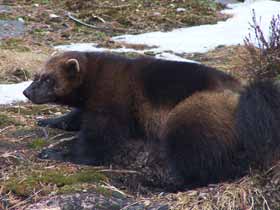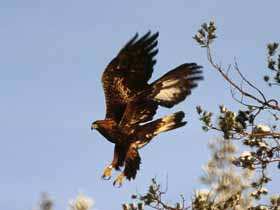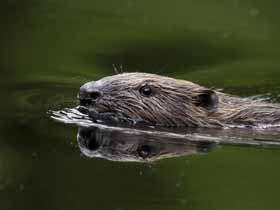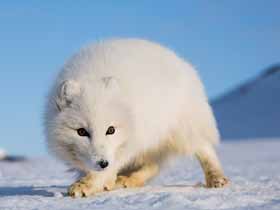Sweden's Big Five
BBC Wildlife magazine
"Why should I visit Sweden?"
"Because it is one of the world's most underrated wildlife destinations. Sweden's vast coniferous forests and pristine lakes and wetlands are packed with exciting species including 2,500 European brown bears, more than 200,000 beavers, 250,000 moose and 200 wolves." Simon Birch, BBC Wildlife magazine
Brown Bear

Photo: Håkan Vargas/ imagebank.sweden.se
Sweden's largest predator, the brown bear, can weigh up to 350kg. It eats mainly berries, ants and shrubs, but may also hunt voles and salmon. The brown bear hibernates during the winter, and cubs are born every two or three years. Sweden has around 2500 bears in the wild. Read more about Brown Bears in Sweden.
Wolverine

Photo: Nature Travels
The wolverine is the largest of the mustelids (a group of animals which includes the badger and the otter), and can weigh up to 30kg. In summer the wolverine feeds mainly on birds and mammals, but in winter will eat reindeer killed either by itself or other predators. Protected in Sweden since 1969, the wolverine is still rare in Sweden, with around 450 wild individuals, and it is still one of Sweden's most threatened species. You may spot the tracks of this shy predator on our Discover Wilderness Canoeing in Rogen experience in the beautiful Rogen reserve in north-east Sweden. Read more about Wolverines in Sweden.
Wolf

Photo: Mikko Nikkinen/ imagebank.sweden.se
The wolf is a social animal, with packs consisting of 10-15 wolves. All the wolves in a pack will be related, e.g. two parents and offspring. During summer, wolves hunt by themselves or in pairs, while in autumn and winter they hunt together in packs to be able to target bigger animals like the elk. The population of wild wolves in Sweden is around 130 individuals. Read more about Wolves in Sweden.
New Blood for the Wolf
The grey wolf was thought to be extinct in Sweden until an isolated population of just 10 individuals was discovered in the southern forests in the 1980s. The population was in a genetic bottleneck with all individuals closely related, but vital new blood was introduced when a lone wolf from Russia migrated into their territory. One study showed that, of the 73 wolf pups born between 1993 and 2001, 68 were related to this one lone migrant.
Today, the Swedish population is once again desperately in need of new blood, and some time ago a Finnish wolf was found to have made its way down the country to join the Swedish wolves in Dalarna. If conflicts between the animals and human interests can be managed successfully, the gene pool of the Swedish wolf may once more have a future.

Nature Travels has previously supported Swedish wolf conservation through Svenska Rovdjursföreningen, the Swedish Predator Society. For more information on the conservation efforts currently supported by Nature Travels, please see Ecotourism.
Golden Eagle

Photo: Håkan Vargas/ imagebank.sweden.se
One of the largest birds of prey, the golden eagle has broad wings and a longish tail and a different outline from the buzzard, which is smaller. It loves to glide on air currents, holding its wings in a shallow V. Golden eagles have nesting places and territories which may by used for generations. Read more about Golden Eagles in Sweden.
Lynx

Photo: Håkan Vargas/ imagebank.sweden.se
Sweden's only feline, the lynx weighs 15-30kg, with males being larger than females. The lynx is a skilful hunter, catching hare, wildfowl and voles, as well as larger animals such as roe-deer and reindeer. It mates in March, with young being born in May. In Sweden the lynx has been protected since 1991, and the wild population is now around 1300. Read more about Lynx in Sweden.
Other Swedish Wildlife
Moose (or Elk!)

Photo: Staffan Widstrand/ imagebank.sweden.se
Sweden's largest mammal, the male moose can weigh up to 700kg. It has brown to greyish-black, with greyish-white legs. This makes the moose hard to see sometimes in the forests. Moose in Sweden number around 210,000 or up to 350,000 at their summer population peak. The Latin name, Alces alces, is known as a "moose" in North America and an älg (elk) in Sweden. But in North America, an "elk" is a deer-like animal otherwise known as a "Wapiti"! Read more about Moose in Sweden or find the answer to the question "What's the difference between a moose and an elk?"
Beaver

Photo: Jörgen Petterson
The beaver became extinct in Sweden in the late 19th century, but was reintroduced from Norway in 1922. Since then it has thrived and populations in Värmland alone number several thousand. It can be up to three feet long not including the tail and weigh up to 65 pounds. Our Timber Rafting on Klarälven and Canoe on Svartälven experiences also give you good chances of spotting this fascinating natural engineer. Read more about Beavers in Sweden.
Arctic Fox

Photo: Asgeir Helgestad/Artic Light AS/visitnorway.com
Arctic foxes do not hibernate and can withstand temperatures of -50 deg C. They are pure white in winter and generally greyish-brown in summer. They may be over a metre long including the tail and weigh up to 8kg. Although they are omnivores, they prefer small mammals such as lemmings, eggs, carrion and berries. Critically endangered with a European mainland population of only around 150, important populations of Arctic foxes inhabit Vindelfjällen Nature Reserve, the setting for some of our dog sledding experiences in northern Sweden. Read more about Arctic Foxes in Sweden and Norway.
Protecting the Arctic Fox
Since 1985, conservationists in the 2100km2 Vindelfjällen Nature Reserve in northern Sweden have been working to monitor and conserve the Arctic Fox population in an important stronghold for this critically endangered species.
The work involves den inventories, radio telemetry and feeding programmes aimed at decreasing the mortality of young pups.
After many years of hard work, Arctic Fox populations are showing signs of recovery.
Sea Eagle

Photo: Staffan Widstrand/ imagebank.sweden.se
The Sea Eagle, or White-Tailed Eagle, is the largest bird of prey in northern Europe. After many years of determined conservation effort, it is now well and truly back from the brink of extinction. Sweden now has around 350 breeding pairs with around 900 young individuals, while Norway has the largest population in Europe with around 11,000 pairs. There are a number of Sea Eagles inhabiting the eastern archipelago and may be seen on our Self-guided Sea Kayaking in St Anna and Gryt experience. Read more about Sea Eagles in Sweden.
Recovery of the Sea Eagle
In 1971, when Project Sea Eagle began working to reverse the decline of Sweden's largest and most powerful raptor, Sea Eagles were on the brink of extinction in Sweden, with a country-wide population reduced to just 150 individuals, largely due to toxins in the food chain affecting egg development.
Today, following more than 30 years of dedicated conservation work, the future for the species in Sweden is once again looking much brighter, with Sea Eagles in Sweden numbering around 1,700.
Grey Seal

Photo: Jörgen Wiklund/ imagebank.sweden.se
The grey seal is the largest of the seal species of Sweden, and may be up to three metres long and weigh up to 300kg. The grey seal will eat many kinds of fish, and while it lives in the sea can survive for long periods on land. One pup is born on an ice floe in February. The population in the Baltic numbers around 6,000. Grey seals inhabit the outer areas of the Stockholm Archipelago.
Capercaillie
The capercaillie is a huge woodland grouse which spends much of its time ground feeding but may also feed on shoots in trees. The large black Capercaillie males are unmistakable.
Roe Deer
The Roe Deer is Sweden's most common deer, seldom weighing over 35kg. Sweden has a population of around a million. In the south and middle of the country the roe deer is common but rarer further north. Red deer and Fallow deer also occur in Sweden but have more scattered populations.
Black Grouse
The males of the black grouse are all black and have a distinctive red wattle over the eye and white stripe along each wing in flight. They have a lyre-shaped tail which is fanned out and raised during display revealing white under-tail feathers. The females are smaller and grey-brown with a slightly notched tail.



